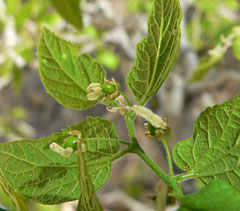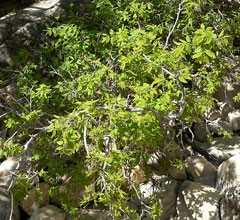 |
|
http://commons.wikimedia.org/wiki/User:Stan_Shebs |
 |
| http://commons.wikimedia.org/wiki/User:Stan_Shebs |
Translate this page:
Summary
Physical Characteristics

 Celtis reticulata is a deciduous Tree growing to 12 m (39ft 4in) at a slow rate.
Celtis reticulata is a deciduous Tree growing to 12 m (39ft 4in) at a slow rate.
See above for USDA hardiness. It is hardy to UK zone 6. It is in flower in April, and the seeds ripen in October. The species is hermaphrodite (has both male and female organs) and is pollinated by Bees.
Suitable for: light (sandy) and medium (loamy) soils, prefers well-drained soil and can grow in nutritionally poor soil. Suitable pH: mildly acid, neutral and basic (mildly alkaline) soils. It cannot grow in the shade. It prefers dry or moist soil and can tolerate drought.
UK Hardiness Map
US Hardiness Map
Synonyms
C. laevigata reticulata. (Torr.)L.Benson.
Plant Habitats
Woodland Garden Canopy; Secondary;
Edible Uses
Edible Parts: Fruit
Edible Uses:
Fruit - raw or cooked[46, 61, 105, 161, 257]. Sweet and fleshy. The fruit can also be made into a jelly or used as a seasoning for savoury foods[183]. It can be dried and stored for winter use[257]. The fruit is about 10mm in diameter[200], it has a thin flesh with a single large seed[K].
References More on Edible Uses
Medicinal Uses
Plants For A Future can not take any responsibility for any adverse effects from the use of plants. Always seek advice from a professional before using a plant medicinally.
Stomachic
The plant has been used in the treatment of indigestion[257].
References More on Medicinal Uses
The Bookshop: Edible Plant Books
Our Latest books on Perennial Plants For Food Forests and Permaculture Gardens in paperback or digital formats.

Edible Tropical Plants
Food Forest Plants for Hotter Conditions: 250+ Plants For Tropical Food Forests & Permaculture Gardens.
More

Edible Temperate Plants
Plants for Your Food Forest: 500 Plants for Temperate Food Forests & Permaculture Gardens.
More

More Books
PFAF have eight books available in paperback and digital formats. Browse the shop for more information.
Shop Now
Other Uses
Wood
A brown or red dye can be obtained from the leaves and branches[257]. Wood - heavy but soft and weak, it is not commercially important[229]. It can be used as a firewood[257].
Special Uses
References More on Other Uses
Cultivation details
Succeeds in any reasonably good soil, preferring a good fertile well-drained loamy soil[1, 11, 200]. Succeeds on dry gravels and on sandy soils[200]. Established plants are very drought resistant[200]. A moderate to slow-growing tree in the wild[229]. It prefers hotter summers and more sunlight than are normally experienced in Britain, so it often does not fully ripen its wood when growing in this country and is then very subject to die-back in winter[1, 11, 200]. Trees can be very long-lived, perhaps to 1000 years[200]. Considered by some botanists to be no more than a sub-species of C. laevigata[149]. Plants in this genus are notably resistant to honey fungus[200].
References Carbon Farming Information and Carbon Sequestration Information
Temperature Converter
Type a value in the Celsius field to convert the value to Fahrenheit:
Fahrenheit:
The PFAF Bookshop
Plants For A Future have a number of books available in paperback and digital form. Book titles include Edible Plants, Edible Perennials, Edible Trees,Edible Shrubs, Woodland Gardening, and Temperate Food Forest Plants. Our new book is Food Forest Plants For Hotter Conditions (Tropical and Sub-Tropical).
Shop Now
Plant Propagation
Seed - best sown as soon as it is ripe in a cold frame[200]. Stored seed is best given 2 - 3 months cold stratification and then sown February/March in a greenhouse[78, 200]. Germination rates are usually good, though the stored seed might take 12 months or more to germinate. The seed can be stored for up to 5 years[113]. As soon as they are large enough to handle, prick the seedlings out into individual pots. The leaves of seedlings often have a lot of white patches without chlorophyll, this is normal and older plants produce normal green leaves. Grow the seedlings on in a cold frame for their first winter, and plant them out in the following late spring or early summer[K]. Give them some protection from the cold for their first winter outdoors. Cuttings
Other Names
If available other names are mentioned here
Native Plant Search
Search over 900 plants ideal for food forests and permaculture gardens. Filter to search native plants to your area. The plants selected are the plants in our book 'Plants For Your Food Forest: 500 Plants for Temperate Food Forests and Permaculture Gardens, as well as plants chosen for our forthcoming related books for Tropical/Hot Wet Climates and Mediterranean/Hot Dry Climates. Native Plant Search
Found In
Countries where the plant has been found are listed here if the information is available
Weed Potential
Right plant wrong place. We are currently updating this section.
Please note that a plant may be invasive in one area but may not in your area so it’s worth checking.
Conservation Status
IUCN Red List of Threatened Plants Status :

Growth: S = slow M = medium F = fast. Soil: L = light (sandy) M = medium H = heavy (clay). pH: A = acid N = neutral B = basic (alkaline). Shade: F = full shade S = semi-shade N = no shade. Moisture: D = dry M = Moist We = wet Wa = water.

Expert comment
Author
Torr.
Botanical References
11200270
Links / References
For a list of references used on this page please go here
Readers comment
| Add a comment |
|
If you have important information about this plant that may help other users please add a comment or link below. Only comments or links that are felt to be directly relevant to a plant will be included. If you think a comment/link or information contained on this page is inaccurate or misleading we would welcome your feedback at [email protected]. If you have questions about a plant please use the Forum on this website as we do not have the resources to answer questions ourselves.
* Please note: the comments by website users are not necessarily those held by PFAF and may give misleading or inaccurate information.
To leave a comment please Register or login here All comments need to be approved so will not appear immediately.
|
Subject : Celtis reticulata
|
|
|
|